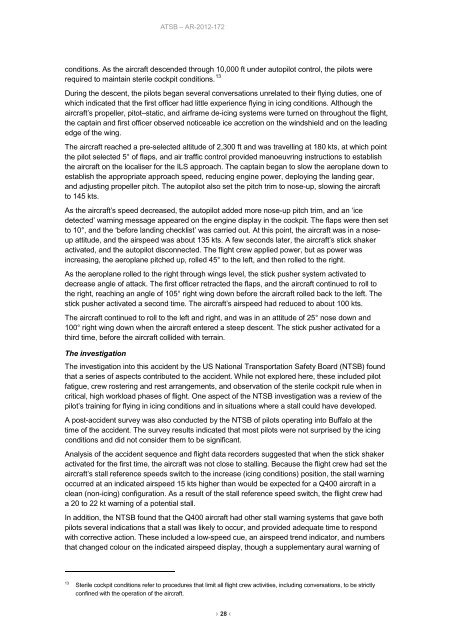Stall warnings in high capacity aircraft: The Australian context 2008 ...
Stall warnings in high capacity aircraft: The Australian context 2008 ...
Stall warnings in high capacity aircraft: The Australian context 2008 ...
Create successful ePaper yourself
Turn your PDF publications into a flip-book with our unique Google optimized e-Paper software.
ATSB – AR-2012-172<br />
conditions. As the <strong>aircraft</strong> descended through 10,000 ft under autopilot control, the pilots were<br />
required to ma<strong>in</strong>ta<strong>in</strong> sterile cockpit conditions. 13<br />
Dur<strong>in</strong>g the descent, the pilots began several conversations unrelated to their fly<strong>in</strong>g duties, one of<br />
which <strong>in</strong>dicated that the first officer had little experience fly<strong>in</strong>g <strong>in</strong> ic<strong>in</strong>g conditions. Although the<br />
<strong>aircraft</strong>’s propeller, pitot–static, and airframe de-ic<strong>in</strong>g systems were turned on throughout the flight,<br />
the capta<strong>in</strong> and first officer observed noticeable ice accretion on the w<strong>in</strong>dshield and on the lead<strong>in</strong>g<br />
edge of the w<strong>in</strong>g.<br />
<strong>The</strong> <strong>aircraft</strong> reached a pre-selected altitude of 2,300 ft and was travell<strong>in</strong>g at 180 kts, at which po<strong>in</strong>t<br />
the pilot selected 5° of flaps, and air traffic control provided manoeuvr<strong>in</strong>g <strong>in</strong>structions to establish<br />
the <strong>aircraft</strong> on the localiser for the ILS approach. <strong>The</strong> capta<strong>in</strong> began to slow the aeroplane down to<br />
establish the appropriate approach speed, reduc<strong>in</strong>g eng<strong>in</strong>e power, deploy<strong>in</strong>g the land<strong>in</strong>g gear,<br />
and adjust<strong>in</strong>g propeller pitch. <strong>The</strong> autopilot also set the pitch trim to nose-up, slow<strong>in</strong>g the <strong>aircraft</strong><br />
to 145 kts.<br />
As the <strong>aircraft</strong>’s speed decreased, the autopilot added more nose-up pitch trim, and an ‘ice<br />
detected’ warn<strong>in</strong>g message appeared on the eng<strong>in</strong>e display <strong>in</strong> the cockpit. <strong>The</strong> flaps were then set<br />
to 10°, and the ‘before land<strong>in</strong>g checklist’ was carried out. At this po<strong>in</strong>t, the <strong>aircraft</strong> was <strong>in</strong> a noseup<br />
attitude, and the airspeed was about 135 kts. A few seconds later, the <strong>aircraft</strong>’s stick shaker<br />
activated, and the autopilot disconnected. <strong>The</strong> flight crew applied power, but as power was<br />
<strong>in</strong>creas<strong>in</strong>g, the aeroplane pitched up, rolled 45° to the left, and then rolled to the right.<br />
As the aeroplane rolled to the right through w<strong>in</strong>gs level, the stick pusher system activated to<br />
decrease angle of attack. <strong>The</strong> first officer retracted the flaps, and the <strong>aircraft</strong> cont<strong>in</strong>ued to roll to<br />
the right, reach<strong>in</strong>g an angle of 105° right w<strong>in</strong>g down before the <strong>aircraft</strong> rolled back to the left. <strong>The</strong><br />
stick pusher activated a second time. <strong>The</strong> <strong>aircraft</strong>’s airspeed had reduced to about 100 kts.<br />
<strong>The</strong> <strong>aircraft</strong> cont<strong>in</strong>ued to roll to the left and right, and was <strong>in</strong> an attitude of 25° nose down and<br />
100° right w<strong>in</strong>g down when the <strong>aircraft</strong> entered a steep descent. <strong>The</strong> stick pusher activated for a<br />
third time, before the <strong>aircraft</strong> collided with terra<strong>in</strong>.<br />
<strong>The</strong> <strong>in</strong>vestigation<br />
<strong>The</strong> <strong>in</strong>vestigation <strong>in</strong>to this accident by the US National Transportation Safety Board (NTSB) found<br />
that a series of aspects contributed to the accident. While not explored here, these <strong>in</strong>cluded pilot<br />
fatigue, crew roster<strong>in</strong>g and rest arrangements, and observation of the sterile cockpit rule when <strong>in</strong><br />
critical, <strong>high</strong> workload phases of flight. One aspect of the NTSB <strong>in</strong>vestigation was a review of the<br />
pilot’s tra<strong>in</strong><strong>in</strong>g for fly<strong>in</strong>g <strong>in</strong> ic<strong>in</strong>g conditions and <strong>in</strong> situations where a stall could have developed.<br />
A post-accident survey was also conducted by the NTSB of pilots operat<strong>in</strong>g <strong>in</strong>to Buffalo at the<br />
time of the accident. <strong>The</strong> survey results <strong>in</strong>dicated that most pilots were not surprised by the ic<strong>in</strong>g<br />
conditions and did not consider them to be significant.<br />
Analysis of the accident sequence and flight data recorders suggested that when the stick shaker<br />
activated for the first time, the <strong>aircraft</strong> was not close to stall<strong>in</strong>g. Because the flight crew had set the<br />
<strong>aircraft</strong>’s stall reference speeds switch to the <strong>in</strong>crease (ic<strong>in</strong>g conditions) position, the stall warn<strong>in</strong>g<br />
occurred at an <strong>in</strong>dicated airspeed 15 kts <strong>high</strong>er than would be expected for a Q400 <strong>aircraft</strong> <strong>in</strong> a<br />
clean (non-ic<strong>in</strong>g) configuration. As a result of the stall reference speed switch, the flight crew had<br />
a 20 to 22 kt warn<strong>in</strong>g of a potential stall.<br />
In addition, the NTSB found that the Q400 <strong>aircraft</strong> had other stall warn<strong>in</strong>g systems that gave both<br />
pilots several <strong>in</strong>dications that a stall was likely to occur, and provided adequate time to respond<br />
with corrective action. <strong>The</strong>se <strong>in</strong>cluded a low-speed cue, an airspeed trend <strong>in</strong>dicator, and numbers<br />
that changed colour on the <strong>in</strong>dicated airspeed display, though a supplementary aural warn<strong>in</strong>g of<br />
13<br />
Sterile cockpit conditions refer to procedures that limit all flight crew activities, <strong>in</strong>clud<strong>in</strong>g conversations, to be strictly<br />
conf<strong>in</strong>ed with the operation of the <strong>aircraft</strong>.<br />
› 28 ‹
















